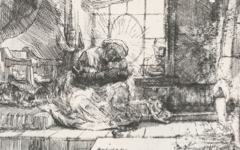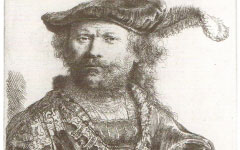Rembrandt’s Self-portrait with a Dead Bittern (1639)
This painting of a young Rembrandt holding up a dead bird as though he were the hunter has troubled art scholars for years. Hunting was a highly regulated sport in the Netherlands confined for the most part to the nobility and officers of state, a social class far removed from Rembrandt’s. He himself could not have been a hunter. Thus some suggest that he was trying to elevate his social status by posing as one, others believe his real intention was to symbolize the immortality of painting.1 Both are probably right because the dead bittern is not what it seems. The bird is Rembrandt’s painting which Rembrandt the young ambitious artist holds up for us to marvel at. Here, viewers, he says, look at my amazing painting! Besides, an extended arm is a little-known but common motif in art for an artist's painting-arm extended towards a canvas. However, in fusing the studio and real life as many great masters have done, Rembrandt is dressed not as if he painted the bird but as if he caught it. He has taken on an aspect of his own painting. And while his costume does suggest social ambition, it is really a visual metaphor for the nobility of his own art and all painting, not him personally.
Do not forget, though, that while there appear to be two levels of reality – the painting in front and the studio behind – there really is only one because the entire scene takes place in the artist’s mind: we are looking at the creative process itself as Rembrandt imagines it. Moreover, in killing the bird, Rembrandt must be using death to symbolize not only the completion and perfection of his painting but his hoped-for attainment of self-knowledge. In the esoteric world death as a metaphor signifies the transition from a concern with the earthly life to an interior one.
More Works by Rembrandt
See how Joseph is an artist staring at his work of art inside the artist's head

Rembrandt’s Holy Family with a Cat (1654)
Scholars have long wondered why Rembrandt would represent himself in expensive and extravagant clothing from a century earlier even though they know that the etched self-portrait is based on an engraving of the fifteenth-century painter Jan Gossaert, known as Mabuse.

Rembrandt’s Self-portrait in Sixteenth-Century Costume (1638)
Notes:
1. Scott A. Sullivan, “Rembrandt’s Self-Portrait with a Dead Bittern”, Art Bulletin 62, 1980, pp. 236-43; Cynthia P. Schneider, “Death by Interpretation: Rembrandt’s Girl with Dead Peacocks” in Rembrandt and his Pupils, ed. G. Cavalli-Bjorkman (Stockholm: Nationalmuseum) 1993, pp.55-67
Original Publication Date on EPPH: 20 Apr 2010. | Updated: 0. © Simon Abrahams. Articles on this site are the copyright of Simon Abrahams. To use copyrighted material in print or other media for purposes beyond 'fair use', you must obtain permission from the copyright owner. Websites may link to this page without permission (please do) but may not reproduce the material on their own site without crediting Simon Abrahams and EPPH.

